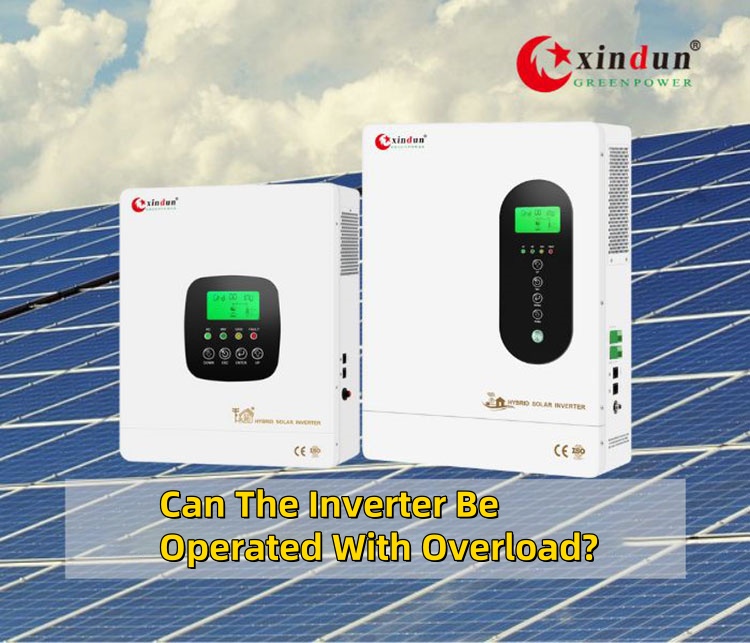
Can the inverter run with overload? It is generally not recommended to run the inverter with overload.
An inverter is an electrical device that converts direct current (DC) into alternating current (AC). For example, 12V DC battery is converted into 220V AC through inverter for AC load devices to connect and run.
When using inverter, users occasionally fail to pay attention to or forget the rated power of the inverter. Once the added load device is connected to the circuit, the inverter and the load device will stop running. However, there is also situation where the user's load power exceeds the rated power of the inverter, but it is still running. So what is the situation?

Usually, the actual output power of the inverter does not reach the rated power, and the power is falsely increased, which is called false power. The actual output power is higher than the labeled rated power, which is the reverse operation.
For example, inverter marked as 1000W rated power may actually be able to continuously and stably output 1500W or even higher power, but the manufacturer marks it as lower power value for some reasons (such as safety factor considerations, market positioning, clearing inventory or complying with specific industry standards, etc.).
Comply with industry standards or certification requirements
Different industries and markets may have strict standards and certification systems. Some certification standards have specific requirements for the power labeling of inverters, and these requirements may be relatively conservative. For example, some international certification agencies stipulate that the labeled power of the inverter should be the stable output power under conditions, such as continuous operation for a certain period of time and meeting certain efficiency and power factor. In order to pass these certifications smoothly, manufacturers may choose low power label to ensure that the inverter can fully meet the standards during testing and actual use.
Safety and reliability factors
Inverters are affected by many factors during operation, such as ambient temperature and component aging. In order to ensure that the inverter can work safely and reliably in various complex practical application scenarios, manufacturers may reserve a certain power margin and then mark it with lower power. For example, in high temperature environment, the heat dissipation performance of the inverter will decrease, and the performance of the components may also be affected. If the marked rated power is too high, safety hazards such as overload may occur in a high temperature environment. By marking the power low, the inverter can have enough performance margin to ensure safe operation even in adverse environmental conditions.
Inverters from some manufacturers are designed with certain overload capacity, which means that they can withstand loads exceeding the rated power for a short period of time or under certain conditions without shutting down immediately. For example, inverter with rated power of 1000W can still operate with load power between 1000W and 1100W.
Some inverters over load protection circuits may have certain delay characteristics. The triggering of over load protection is usually based on the monitoring of parameters such as current, voltage or power. The protection will not be activated until these parameters exceed the set threshold for a certain period of time. If this delay time is relatively long, the inverter may continue to operate in the early stage of overloading.
The over load protection mechanism may be insensitive due to faults or design defects. For example, the accuracy of the sensor used to monitor power is not enough, or there are deviations in components, such as comparators in the protection circuit, resulting in inaccurate judgment of over-power conditions, so that the inverter does not stop working in time when overloading occurs.
Over load protection of inverter is triggered
Most inverters are equipped with overload protection mechanism. When the load power exceeds the rated power of the inverter to certain extent (usually about 120% - 150%), the over load protection circuit will automatically respond to stop the inverter from working to avoid damage to internal components. For example, inverter with rated power of 1000W will trigger overload protection and automatically cut off power and stop running when the load power reaches about 1200W-1500W.
Performance degradation and output abnormality
When approaching but not yet triggering overload protection, over load loading may cause the output voltage of the inverter to be unstable and the frequency to fluctuate, and the waveform to be distorted. This may cause abnormal operation or even damage to the load equipment for some loads with high requirements for voltage and frequency stability, such as precision electronic equipment, motors, etc.
Component damage and safety hazards
If there is no effective overload protection or the overload protection fails, long-term overpower operation may cause the power devices (such as power tubes) inside the inverter to burn out. Once the power device is damaged, it may cause faults such as short circuits, or even safety accidents. Therefore, although some manufacturers' inverters can still operate with slight overpower for a short period of time, and may not cause immediate damage, in order to ensure the normal operation of the inverter, extend its service life and ensure safety, it is generally not recommended to operate the inverter with overpower load, and it should be used safely in accordance with the product manual specifications.
All inverters from Xindun Power are designed to deliver full power output, with additional overload margin, overload alarm, and protection features. Our LF series low-frequency inverters, HFP series high-frequency inverters , HP PLUS+ series parallel inverters, and HDSX series three-phase inverters have received high praise from global customers for both quality and pricing.
Here we recommend 4 most popular inverters. Click on the pictures to jump to product details: